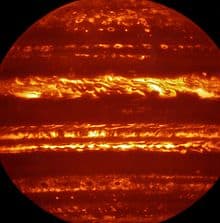
Scientists working on NASA’s Juno mission to Jupiter shared a 3-D infrared movie depicting densely packed cyclones and anticyclones that permeate the planet’s polar regions, and the first detailed view of a dynamo, or engine, powering the magnetic field for any planet beyond Earth.
Juno mission scientists have taken data collected by the spacecraft’s Jovian InfraRed Auroral Mapper (JIRAM) instrument and generated the 3-D fly-around of the Jovian world’s north pole. Imaging in the infrared part of the spectrum, JIRAM captures light emerging from deep inside Jupiter equally well, night or day. The instrument probes the weather layer down to 30 to 45 miles below Jupiter’s cloud tops. The imagery will help the team understand the forces at work in the animation—a north pole dominated by a central cyclone surrounded by eight circumpolar cyclones with diameters ranging from 2,500 to 2,900 miles.
“Before Juno, we could only guess what Jupiter’s poles would look like,” said Alberto Adriani, Juno co-investigator from the Institute for Space Astrophysics and Planetology, Rome. “Now, with Juno flying over the poles at a close distance it permits the collection of infrared imagery on Jupiter’s polar weather patterns and its massive cyclones in unprecedented spatial resolution.”
Another Juno investigation was the team’s latest pursuit of the interior composition of the gas giant.
“Prior to Juno, we could not distinguish between extreme models of Jupiter’s interior rotation, which all fitted the data collected by Earth-based observations and other deep space missions,” said Tristan Guillot, a Juno co-investigator from the Université Côte d’Azur, Nice, France. “But Juno is different—it orbits the planet from pole to pole and gets closer to Jupiter than any spacecraft ever before. Thanks to the amazing increase in accuracy brought by Juno’s gravity data, we have essentially solved the issue of how Jupiter’s interior rotates: The zones and belts that we see in the atmosphere rotating at different speeds extend to about 1,900 miles.
“At this point, hydrogen becomes conductive enough to be dragged into near-uniform rotation by the planet’s powerful magnetic field.”
The same data used to analyze Jupiter’s rotation contain information on the planet’s interior structure and composition. Not knowing the interior rotation was severely limiting the ability to probe the deep interior. “Now our work can really begin in earnest—determining the interior composition of the solar system’s largest planet,” said Guillot.
Juno is only about one-third of the way through its planned mapping mission and already we are beginning to discover hints on how Jupiter’s interior dynamo works.
Juno has logged nearly 122 million miles to complete 11 science passes since entering Jupiter’s orbit on July 4, 2016. Juno’s 12th science pass will be on May 24.
More information on the Juno mission:
https://www.nasa.gov/juno
https://www.missionjuno.swri.edu
Follow the mission on Facebook and Twitter:
https://www.facebook.com/NASAJuno
Tweets by NASAJuno
More information on Jupiter:
https://www.nasa.gov/jupiter
Editor’s Note: School Board member Dr. Steve Levin is the Project Scientist on the Juno Mission


Be the first to comment